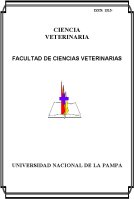Tuberculosis bovina relación de proporciones entre los diagnósticos anatomopatológicos macroscópico y microscópico
Keywords:
Cattle, Tuberculosis, Histopathology diagnosisAbstract
At present exists a National Plan of Control and Eradication of Bovine Tuberculosis, which more important methodology for the prevalence estimation through the macroscopic anatomopathology diagnosis of affected animals in the abattoirs. To make reliable these data, it realize study like hystophatology diagnosis. At present, the correlation found about this diagnosis with respect to the macroscopic was between 54 to 90%. The purpose of the present work was to analyze one of the incident factors in the amplitude of the finded correlations, increasing the numbers of samples of each suspected sicks individuals. The 60,40% of studied samples about histopathology method were confirmed (considering only one subsample) and the 69.80% were confirmed by the diagnosis of more one subsample. To enhance the sensibility and the sensibility of histopathology diagnosis it decided to do specific cultures in the positives and the negatives samples. The results were the following: the sensibility of histopathology diagnosis was 71,15% and the specificity was 97,77%. The prevalence of the animal population studied and in the time analyzed was in order of 2,64%Downloads
Downloads
Published
How to Cite
Issue
Section
License
Al momento de enviar sus contribuciones, los colaboradores deberán declarar , de manera fehaciente, que poseen el permiso del archivo o repositorio donde se obtuvieron los documentos que se anexan al trabajo, cualquiera sea su formato (manuscritos inéditos, imágenes, archivos audiovisuales, etc.), permiso que los autoriza a publicarlos y reproducirlos, liberando a la revista y sus editores de toda responsabilidad o reclamo de terceros , los autores deben adherir a la licencia Creative Commons denominada “Atribución - No Comercial CC BY-NC-SA”, mediante la cual el autor permite copiar, reproducir, distribuir, comunicar públicamente la obra y generar obras derivadas, siempre y cuando se cite y reconozca al autor original. No se permite, sin embargo, utilizar la obra con fines comerciales.




.jpg)

4.png)


7.png)



